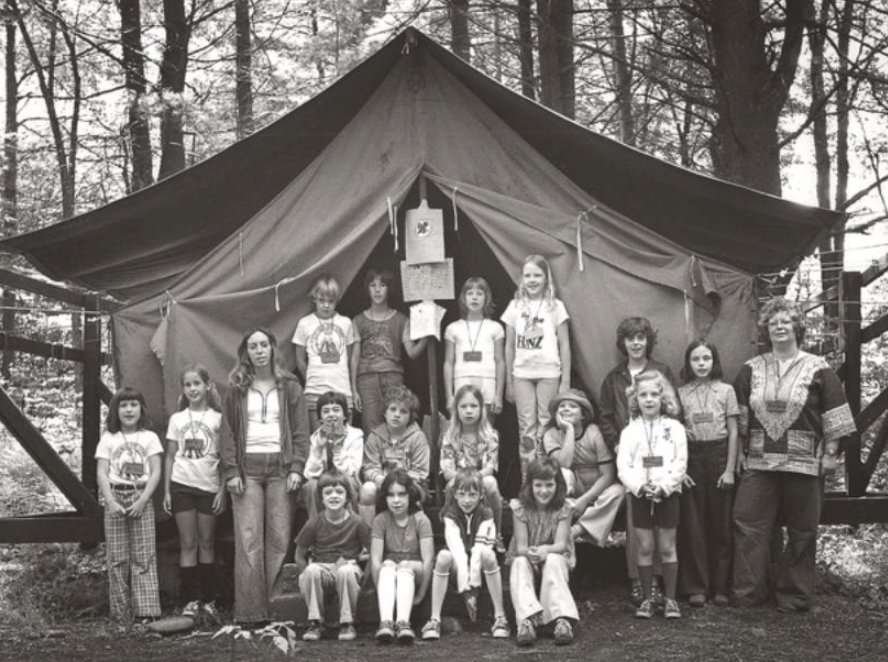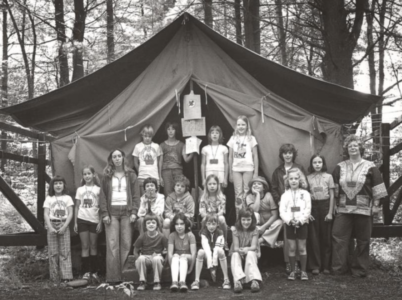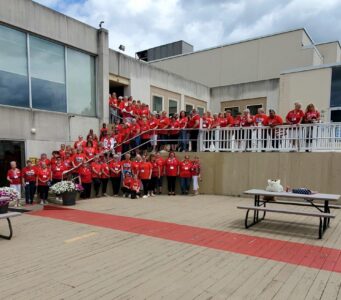Girl Scout Camp Lycogis: A legacy of adventure and community

For more than 60 years, Girl Scout Camp Lycogis provided a place of adventure, learning, and community for countless girls. The camp’s history reflects the determination and hard work of the Lycoming County Girl Scouts.
The origin of Camp Lycogis dates back to 1943, when the Girl Scouts purchased 112 acres of land along Loyalsock Creek. Despite the challenges posed by World War II, including a scarcity of materials and labor, a group of 16 men from the former Williamsport Technical Institute (now Pennsylvania College of Technology) built the first units and the main lodge.
The camp officially opened its doors to campers in the summer of 1944, welcoming 211 girls and 15 counselors for six one-week sessions. The cost was $15 per week, with scholarships available. Before the establishment of Lycogis, the Girl Scouts used the Boy Scout facility, Camp Cline near Jersey Shore, for two weeks in August when the regular camping season was over.
Reputation grew
Camp Lycogis quickly gained a reputation for its excellent facilities and programs. By its fifth camping season, the camp had grown significantly, hosting 350 girls and featuring a large dining pavilion. In 1961, there were 880 girls. The camp’s location (actually in Sullivan County) on Route 87 between Barbours and Hillsgrove, just 28 miles from Market Square, made it accessible yet secluded enough to provide a true outdoor experience.
Rae Lynn Cox, former director of communications for the Girl Scouts, stated that the Girl Scout programs aimed to help girls learn new skills and build self-esteem by overcoming challenges in a safe, all-girl environment. Campers sometimes paid for their stay by selling Girl Scout cookies.
“From [the camp’s] inception until the mid 1970s, the core programs centered around environmental education, mountain arts, basic camp craft skills, swimming, and hiking” (The Grit, 6/22/1975). Later changes in programming brought sports such as biking, canoeing, and sailing. A ropes course, climbing wall, and rock climbing were eventually added.
Cabins, tents and shacks
The accommodations were simple. The youngest girls stayed in Tall Pines (cabins); older girls lived in Minnehaha and Gypsies (both tents); and the oldest girls, the Pioneers, stayed in what they called the “Adirondack shacks.” The units changed names over the more than 60 years the camp was open, but whatever the name, the campers became very attached to–and took great pride in–their units.
The waterfront along the creek was adapted for swimming, boating, and sailing. Each girl wore a bathing cap, the color of which signified her swimming ability: red for beginners, blue for intermediates, and white for experts, who were allowed to dive off the diving board.
My time at Lycogis
It was in the early years that my sister and I and our friends (now in their 80s) went to Lycogis. Christine Plankenhorn Tischer attended from the time she was 7 until she was out of college. Her mother, Virginia Plankenhorn, was the camp director at the time. Susan Schneebeli Belin and her sister Marta Schneebeli were at Lycogis several summers. Susan said that the camp changed her life–gave her confidence in herself and a sense of independence. Other girls whom I remember include Polly Ribando, Dottie Ribando, Penny Hain, Ann McCracken, Marsha Walters Bergman, and Carol Scruggs.
My sister, Ann Sieminski Hernandez, vividly recalls a day when the campers were out marching in the rain and she, unable to make it to the latrine in time, peed in her pants. As a Brownie, I enjoyed my first season there, especially the swimming; but the next summer, worried because I did not have the required mess kit, I cried and my parents came and took me home. (I am still a worrier.)
While doing research for this article, I found an awesome story. One night In August 1956, there were prowlers at the camp–eight boys from the nearby area. The Grit (8/5/1956) reported that the boys were apprehended after three of them were “captured” by the girls. The Scouts “held clubs and flashlights over their heads until the police arrived.” The girls had also disconnected wires from the cars the boys used so that they could not drive away.
Challenges
In the 1980s, camps faced challenges to stay relevant, having lost their uniqueness. At Lycogis, new programs and activities, including a rope course and a challenge course.
Not only Lycogis, but many Girl Scout camps across the country were struggling to remain relevant amid shifting cultural and economic trends. As more women joined the workforce, there were fewer stay-at-home parents to support scouting activities or send their daughters away for extended summer programs. At the same time, new types of specialized camps–offering focused experiences in sports, technology, and the arts–began drawing girls away from traditional outdoor programs.
According to sources consulted by ChatGPT, Girl Scouts also faced rising costs to maintain facilities, meet updated safety standards, and provide trained staff. Liability concerns grew, requiring stricter oversight and increasing expenses. Meanwhile, many young girls began to show less interest in rustic, screen-free settings, gravitating instead toward faster-paced, technology-driven experiences. Despite efforts to modernize programming, the traditional summer camp model started to feel outdated for a new generation, contributing to the decline of many beloved resident camps by the early 2000s.
Camp closes
In February 2010, the Girl Scouts announced that Camp Lycogis was closing indefinitely. The summer camp had suffered extensive damage due to heavy rains and flooding in January. Although the camp had suffered flood damage before and volunteers had helped clean up the camp and repair facilities, this time flood waters had damaged several camp buildings, spread destructive debris along the challenge course, and even washed out bridges leading to and from the camp property. While initially hopeful that the damage could be addressed, the Girl Scouts soon realized that the destruction posed significant safety hazards that would be very difficult to overcome.
Legacy endures
Often when I tell people that I am writing a newspaper story on Camp Lycogis, former campers’ faces light up and they tell stories of their own Lycogis days. One former camper broke into a rendition of “There’s a Camp Along the Mountainside” in the restaurant where we were eating dinner.
Several former campers gave me permission to share their stories. Lanette Ruffander wrote: “I realize now that one of my favorite moments at camp was when it was time to lower the American flag each night. . . . there was this calming, peaceful silence that fell over the group of energetic and giggly scouts that formed a horseshoe in front of the flag pole. . . . then all heads turned to watch the lucky group of girls up by the lodge who walked quietly down through the wet grass and all we heard were their steps . . . ‘swish, swish, swish, swish.’ The flag was respectfully lowered and then folded as perfectly as possible as each scout had been taught . . . kept safely until the next morning when another group of girls would be given the honor of raising the flag. In the old days I suppose I looked at that moment as one of the ways we marked day’s end. But looking back I realize that it gave me such a peaceful, thoughtful, safe and special feeling. (Knowing my mother walked those same steps as a young girl made it even more special.)”
Patty Toretti shared this memory: “My twin sister and I were there; I surmise Summer 1952. It was a fun experience. One night I had to go to the latrine. My twin walked with me and suddenly we saw a long black snake following us. Of course, we screamed and the counselors came running. Later that day they cut that snake open. They found baby mice inside. I’m 78 and still remember that experience and have told that experience often through the years.” Patty’s twin, Jane Koss, recalled that event, too.
Several former campers reported that their mothers went to Lycogis. Some even remembered that both their mothers and their grandmothers were campers. Juli Daniels recounted this story: “My family and I used to attend family camp at Lycogis every Memorial and Labor Day weekend. This started before I was born and continued for 40+ years until the camp was shut down. When Lycogis closed, it was absolutely devastating to my family and the lifelong friends we had made at camp. My grandmother, Marilyn Zimmerman Sites, passed away earlier this year and one of her wishes was for her ashes to be spread at Lycogis. The new owners graciously permitted my family to fulfill her wish this past weekend.”
Lycogis today
My husband, Richard Allen, and I drove out to the now-abandoned Lycogis several weeks ago, and it was sad. As Juli Daniels wrote: “Being at camp was bittersweet. It was so heartbreaking, though, to see the state the camp is in. Everything is overgrown. The bridge is washed away. The buildings in disrepair and covered in mold and animal droppings. The dining hall still filled with dishes and the arts and crafts building with crafting supplies. No path to the swimming hole or the ropes course. No water in the creeks or stones on the beach.”
Despite its closure, memories of Camp Lycogis are kept alive by those who spent summers there. A private Facebook group, Camp Lycogis Memories & Friends (https://www.facebook.com/groups/lycogis/), administered by Bobbi Burke, has 852 members. It features posts containing memories and photos of the camp and campers and allows former campers to reconnect and memories to be kept alive.
Mary Sieminski, a Williamsport native, is a founder of the Lycoming County Women’s History Project. A former professor and librarian, she served as the director of the Pennsylvania College of Technology Library.


